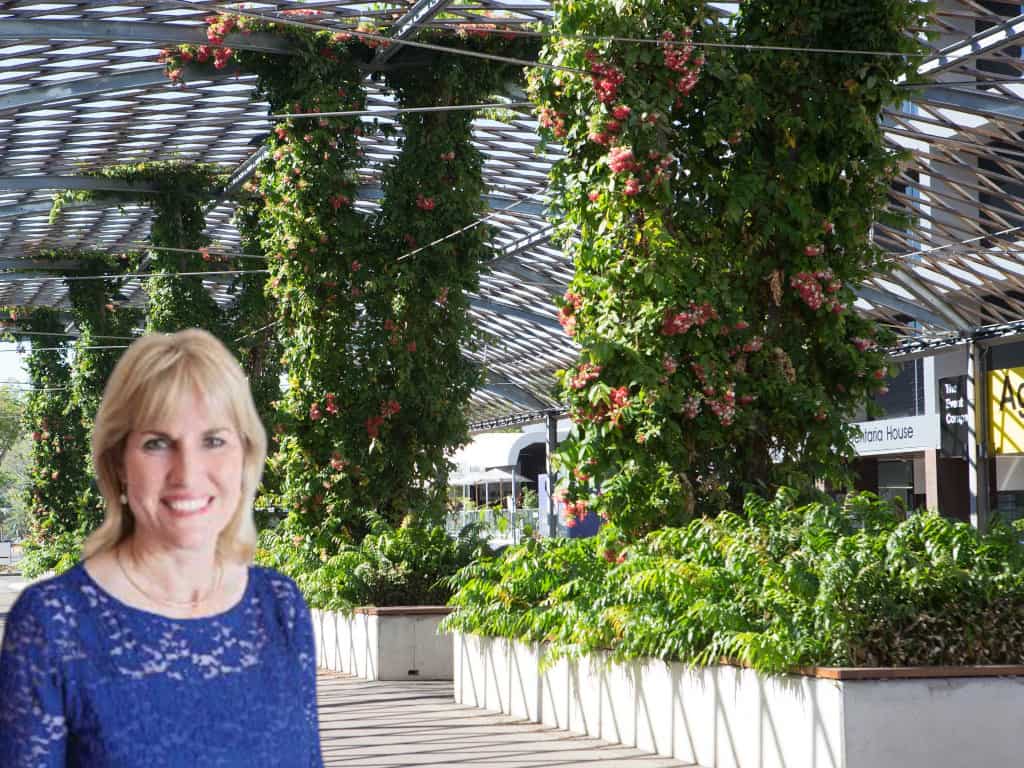A former NT Parks superintendent has said the $2.7 million Cavenagh St shade structure’s vines could take 18 years to fully cover the top of it, while the landscape architect whose firm selected the plants said the project was “experimental to some extent”, with the vines still far from covering the structure about seven months past the Territory Government’s forecast timeframe.
On the last day of October 2018 then Infrastructure Minister Nicole Manison said the Rangoon creeper and orange trumpet vines would grow to full size in 12 to 18 months. The following February the next Infrastructure, Minister Eva Lawler, said it was anticipated vines should have covered the structure by May 2020
The vines have reached the top of the central posts and have grown a metre or so each way over the lattice supporting structure that runs across the top which is about 55m long and 30 metres wide. The shade structure in Cavenagh Street is part of the tri-government Darwin City Deal under its heat mitigation projects.
Tony Cox, the director of Landscape architects Clouston Associates, the firm contracted by the Department of Infrastructure, Planning and Logistics for the plantings, told ABC Darwin radio it was very difficult to determine just how quickly the vines would grow. He questioned the government’s initial prediction of having full cover in 18 months.
“We are talking about a growing plant, and it’s very difficult to determine just how quickly they will grow and, and so forth,” he said.
“Then, the other one too that we need to consider here is, the whole shade structure itself is something like over a 1,000 square meters.
“It’s a very large structure, and to even get a tree to get a coverage on such a large area would take five trees and probably 15 years, so the whole project was experimental to some extent. The vine itself. The vine has done well. But we are asking it to grow essentially like a tree, not just a vine. It has to behave like a tree and cover a very, very large area.”
“The project received horticultural advice from two of the most long standing, experienced horticulturalists in the Territory, and then we made that selection and selected a plant that we believe was of the suggested varieties are the most vigorous and most likely to succeed.”
Mr Cox was asked if $2.7 million was a lot of money to spend for something that was experimental, he said: “Keep in mind the $2.7 million involves a whole lot of other things so there’s infrastructure, there’s power and water, and so forth…There’s a whole lot of other things in there, apart from just the structure and the plants.”
He said there was already a lot of shade in the morning and the afternoon from the vine already.
Mr Cox later described the project as a trial not an experiment.
In mid November Ms Lawler told the NT News she remained optimistic the vines were “healthy” and would improve with a good wet season while rejecting that the project has been a failure.
She would not comment on whether the government would consider tearing out the vines are replacing them with other species.
But former NT Parks superintendent John Antella told the ABC from his observations the orange trumpet seemed to have died.
“I could be wrong, but that’s just what I’ve noticed driving by,” he said.
“…I wouldn’t pull it out. I think you’ve got to live with it. But you know, you’ve probably got to wait eighteen years for it to do what it was supposed to do in 18 months.
“So they probably need to change the sign down there [on Cavenagh St], to you know, say approximately 18 years [from 18 months]. I am not being critical of anyone who was involved but the reality is the Rangoon creeper has been historically known as a rambling shrub and a clambering shrub, it’s not described as a climber.
“If they wanted a shade structure there, they should have really put an impervious cover over the top of the shade structure, which was heat reflective, and we would have had, you know, a shade structure, which we’re not going to get now.’
This would mean a child who was born when the vines were planted would have finished high school by the time they had covered the structure.
He said he was told there was a new Rangoon creeper hybrid from Asia but there was no mention of what variety was used on the shade structure.
Previously Mr Antella had told media, expecting those vine species to grow over the structure was, “a bit like expecting a Toyota Corolla to go where you need a Toyota LandCruiser”.
Ms Lawler was contacted for comment, including being asked what information she relied on to make her initial calculation that the growing time would be 18 months, when those responsible for selecting the plants would not put a timeframe on the full coverage? And why she did not disclose the experimental nature of the project and that the growing time could not be known?
Earlier, the NT Government said in a statement to media the original forecast period for the vines to reach a “reasonable level of coverage” was 18 months, which contradicted the press release Ms Lawler put out in early 2019.
They said the vines had suffered from an infestation in their infancy as well as overzealous pruning which had contributed to sluggish growth.




0 Comments